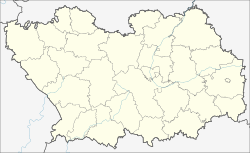Kamenka (Pensa)
| city
Kamenka
Каменка
|
||||||||||||||||||||||||||||||||||||||||
|
||||||||||||||||||||||||||||||||||||||||
|
||||||||||||||||||||||||||||||||||||||||
| List of cities in Russia | ||||||||||||||||||||||||||||||||||||||||
Kamenka ( Russian Каменка ) is a city in Penza Oblast ( Russia ) with 39,577 inhabitants (as of October 14, 2010).
geography
The city is located on the western edge of the Volga plate about 75 km west of the oblast capital Penza on the Atmis , a left tributary of the Mokscha in the river system of the Volga .
Kamenka is the administrative center of the Rajons of the same name .
The town lies on the 1874 opened railway Ryazhsk -Pensa- Sysran (Station Belinskaja ).
history
The village of Kamenka was established in the 18th century.
After an agricultural machinery plant was relocated from the western part of the Soviet Union to Kamenka after the beginning of the Second World War , the population grew rapidly, so that the place received the status of an urban-type settlement on June 15, 1944 and town charter on April 18, 1951.
Population development
| year | Residents |
|---|---|
| 1795 | 1,197 |
| 1897 | 3,409 |
| 1926 | 5,229 |
| 1939 | 8,265 |
| 1959 | 25,219 |
| 1970 | 30,067 |
| 1979 | 35,274 |
| 1989 | 40.134 |
| 2002 | 40,712 |
| 2010 | 39,577 |
Note: from 1897 census data
Culture and sights
The city has a local history museum, which is housed in an Art Nouveau bank building built between 1911 and 1913 . In addition, other buildings from this period, such as the post office from 1913 and the palace (1914) of Count Vladimir Vojeikow (1868–1942, the most influential landowner in the area, major general, commander of the palace guard Nicholas II , first president of the Russian Olympic Committee ).
economy
The largest plant in the city is the Agricultural Engineering Plant ( Belinskselmasch ), there is also a construction and food industry ( Atmis-sachar sugar factory , which was one of the largest in the Soviet Union when it opened in 1975).
Individual evidence
- ↑ a b Itogi Vserossijskoj perepisi naselenija 2010 goda. Tom 1. Čislennostʹ i razmeščenie naselenija (Results of the All-Russian Census 2010. Volume 1. Number and distribution of the population). Tables 5 , pp. 12-209; 11 , pp. 312–979 (download from the website of the Federal Service for State Statistics of the Russian Federation)
Web links
- Rajon and City Administration website (Russian)
- Kamenka on the private website inpenza.ru (Russian)
- Kamenka on mojgorod.ru (Russian)




